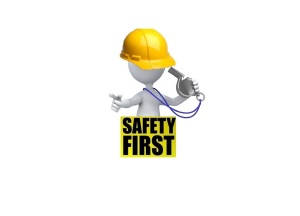OSHA’s New Recordkeeping Rule
Effective January 1, 2015, the Occupational Safety and Health Administration (OSHA) has revised its recordkeeping rule.  Assistant Secretary of Labor for Occupational Safety and Health, Dr. David Michaels, says “OSHA will now receive crucial reports of fatalities and severe work-related injuries and illnesses that will significantly enhance the agency’s ability to target our resources to save lives and prevent further injury and illness. This new data will enable the agency to identify the workplaces where workers are at the greatest risk and target our compliance assistance and enforcement resources accordingly.”
Assistant Secretary of Labor for Occupational Safety and Health, Dr. David Michaels, says “OSHA will now receive crucial reports of fatalities and severe work-related injuries and illnesses that will significantly enhance the agency’s ability to target our resources to save lives and prevent further injury and illness. This new data will enable the agency to identify the workplaces where workers are at the greatest risk and target our compliance assistance and enforcement resources accordingly.”
OSHA’s new recordkeeping rule updates the list of industries exempt from the current requirement to regularly maintain OSHA industry & illness records and it expands the current list of severe work-related injuries that all employers covered under the new rule must report to OSHA.
Any employer with ten or fewer employees at all times during the previous calendar year (no matter what the industry classification) is still partially exempt from the recordkeeping requirement. However, all employers (including those exempt due to industry size or classification) “must report to OSHA any workplace incident that results in an employee fatality, in-patient hospitalization, amputation, or loss of an eye.”
Effective January 1, 2015, all employers must report all work-related fatalities within 8 hours and all work-related inpatient hospitalizations, all amputations, and all losses of an eye within 24 hours. The new recordkeeping rule covers any establishment located in states under Federal OSHA jurisdiction and requires compliance by January 1, 2015. Those establishments located in states operating their own safety and health programs are advised to check with their state plan for implementation dates. Source (current as of 12/22/2014): osha.gov
Making Safety Training More Interesting For Staff
It is not always easy to find the “fun” in safety, but it’s an important concept for safety managers. Keeping staff interested and motivated to comply, adhere to, and change with ever-evolving operational guidelines is imperative.  Whether it’s enticing employees with the option of Made in America safety apparel or providing them resources with which to educate themselves on their options, class definitions, requirements, and industry guidelines, a clear and concise approach is key.
Whether it’s enticing employees with the option of Made in America safety apparel or providing them resources with which to educate themselves on their options, class definitions, requirements, and industry guidelines, a clear and concise approach is key.
In December, we discussed the 4 C’s of Coaching to Safety—useful training points in making safety training more interesting for employees. Managers would benefit in:
- Creating the opportunity for staff to understand why safety is important and resources from which they can choose their safety apparel.
- Communicating the reasons behind safety guidelines and encourage employees to ask questions.
- Coaching to staff resistance and be prepared for rebuttals.
- Maintaining consistency when discussing occupational safety guidelines and stay abreast of changing policies to iterate to employees.
Often times, staff is concerned about a particular issue as it relates to them. For example, workers who do lifting on a regular basis may find interest in the variety of back braces and supports available. Not only does showing concern for your staff boost morale, presenting options to better their health and safety engages and motivates.
An example of the resources you can make available to your staff would be training offered through the American National Standards Institute (ANSI). On the ANSI website, courses are available that cover topics such as standards, updates, and leadership strategies and skills. Providing employees with this information increases the likelihood they will engage in classes and research additional resources on their own. There are even standards learning resources for K-12 students!
Changes in Shipping Costs
You may have heard the criteria with which shipping charges are calculated through FedEx and UPS have changed effective December 29th 2014 for UPS and January 5th 2015 for FedEx. On September 16, 2014,  FedEx announced its general rate increase (GRI) for 2015 and UPS made its announcement the following October. On the surface, the two announcements are identical—citing a 4.9% annual rate increase for 2015. The new FedEx rates apply to FedEx Ground, FedEx Express, FedEx Freight, and import and U.S. export services. The new UPS rates apply to UPS Ground, Air, International, UPS Air Freight, and UPS Freight.
FedEx announced its general rate increase (GRI) for 2015 and UPS made its announcement the following October. On the surface, the two announcements are identical—citing a 4.9% annual rate increase for 2015. The new FedEx rates apply to FedEx Ground, FedEx Express, FedEx Freight, and import and U.S. export services. The new UPS rates apply to UPS Ground, Air, International, UPS Air Freight, and UPS Freight.
What this means for you:
If you ship product, you will notice that both carries are applying dimensional weight pricing (DIM) on all ground packages. Lightweight and residential parcel shippers will be impacted the most. Be mindful 4.9% is just an average. Shippers would benefit to perform a detailed analysis of their pricing agreements, package characteristics, and services to gain a better understanding of how the new rates will impact their transportation costs.
Please refer to UPS and FedEx for specifics on 2015 rate changes.
Protecting Yourself Extends to the Internet
Online hackers have created a valid fear with concern to protecting yourself from Internet vulnerability. Whether it is confidential / proprietary information for your business or personally identifiable information being exposed, the threat is real and everyone must take responsibility to protect information when using computers and mobile data devices. There are a vast amount of antivirus and malware software available to end users, much of which is free.
What people need to realize is a mobile device (tablet, cellular phone) is as vulnerable—if not more so—than a computer and it needs to be protected as well. Antivirus and anti-phishing software such as CM Security and AVG are available through Android app stores and password protecting and encrypting software such as Keeper are available in iOS and Android versions. Protecting your identity is exceptionally important and knowledge is power, whether in cyberspace or real life.
Shop by Standard
Did you know that you can shop for your Personal Protective Equipment (PPE) by standard? While it is always recommended to speak with your safety manager with any questions about class requirements, you have many options and finding the right apparel is easier than you think!
Performance Classes
If you work street side or on in a job that enforces the right-of-way highway guidelines and you are exposed to approaching traffic or in a construction environment, you are required by OSHA to wear HI Vis garments in compliance with Personal Protective Equipment (PPE) standards. This includes emergency workers who work in situations after an emergency has transpired. The requirements are dependent upon the exposure to risk. Ultimately, it is the responsibility of your Safety Manager to determine the need for Hi Vis apparel and the employee’s job to adhere to any guidelines set forth. As always, check with your Safety Manager if you have questions about what is required.
Most employers will require workers to comply with The American National Standard Institute criteria for High-Visibility Safety Apparel and Headwear (ANSI / ISEA 107-2010). These standards set performance criteria on background, combined performance, and retroreflective material. Source (current as of 12/26/2014): ansi.org
ANSI and the International Safety Equipment Association (ISEA) have three numbered performance classifications for Hi Vis apparel that can be broken down in the following table:

What Class is Appropriate For You?
The following table is a tool with which to assess which class your job description falls into, but we cannot emphasize enough that it is a worker’s responsibility to check with his or her Safety Manager to determine what is required.

THE NFPA Needs Your Help
The National Fire Protection Association (NFPA) is asking for your help on a Tentative Interim Amendment (TIA). The NFPA needs public comments to help determine if the Standard on Protective Clothing for Emergency Medical Operations should be updated. This comes in the heels of the recent Ebola outbreaks and the amendment is designed to better protect first responders from contraction, “[following] work conducted by several organizations and federal agencies that recognized the need for a national PPE standard to protect emergency first responders against the Ebola Virus and other liquid-borne pathogens.”
The TIA is posted for public review with a deadline of January 15, 2015. If you would like to submit a comment for review by the 01/15/15 deadline, email: TIAs_Errata_Fls@nfpa.org.






